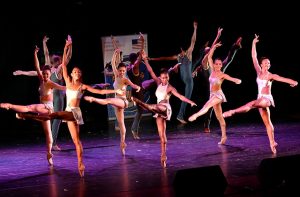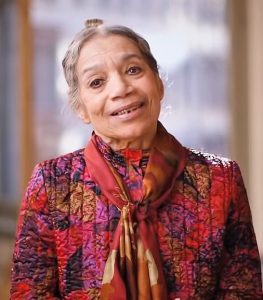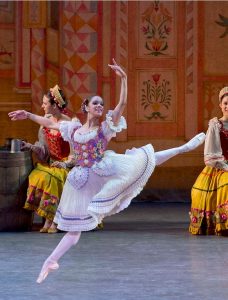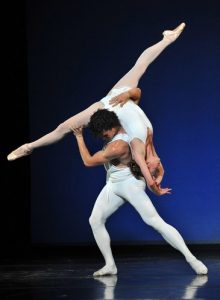
Contemporary ballet is a dance genre that uses classical techniques (French terminology) that choreographers manipulate and blend with other dance forms, such as modern dance.
Alonzo King LINES Ballet
Alonzo King is an American choreographer who initially studied at the ABT. King also danced with notable choreographers Alvin Ailey and Arthur Mitchell before founding his company, LINES Ballet. LINES Ballet is located in California, where King uses Western and Eastern classical dance forms to create contemporary ballets.
BalletX
BalletX was founded in 2005 by Christine Cox and Matthew Neenan and is located in Philadelphia. The mission of BalletX is to expand classical vocabulary through its experimentation to push the boundaries of ballet.
Watch This
Christine Cox and Matthew Neenan discuss the mission of BalletX. The footage shows clips of the company’s performances, pictures, and interviews with the company members.
Complexions Contemporary Ballet
In 1994, Complexions was founded by Dwight Rhoden and Desmond Richardson. The mission of Complexions is to foster diverse and inclusive approaches in the making and presentation of their works to inspire change in the ballet world.
Watch This
Excerpt from WOKE that uses music from Logic to explore themes of humanity in response to the political climate.
From its origins in the elite white-only courts of France and Italy and well into the present day, western dance forms had a history of exclusionism. In the United States, the first Black ballet dancer who broke the color barrier in 1955 to dance in a major ballet company was Raven Wilkinson. Wilkinson danced and toured with the Ballet Russe de Monte Carlo. Racial segregation was at its height during this time, forcing Wilkinson to deny her race when performing at most venues. After facing years of discrimination, Wilkinson eventually left the Ballet Russe de Monte Carlo. After facing rejection from several American ballet companies, Wilkinson was hired to dance with the Dutch National Ballet. Wilkinson later became a mentor to Misty Copeland.

In 2015 Misty Copeland became the first African American female principal dancer with American Ballet Theatre. Copeland is also the first woman of color to take the lead role of Odette/Odile in Swan Lake. Her road to principal dancer was difficult as many claimed she had the wrong skin color to dance professionally. Due to the racism faced throughout her life, Misty Copeland uses her platform to bring awareness to the challenges people of color face in the ballet world by advocating for diversity.
Watch This
Misty Copeland’s interview on race in ballet.

Racial barriers have caused choreographers to challenge the traditional Eurocentric forms of ballet. Hiplet, a fusion of ballet movement and hip-hop, was created by Homer Hans Bryant to provide opportunities for dancers of color to connect to ballets and express themselves in a contemporary and culturally relevant way.
Watch This
In this video, Hiplet creator Homer Hans Bryant discusses how he developed this dance style.

Ballets historically tend to follow stereotyped gender roles that emphasize femininity and masculinity. These conventional standards are reinforced in the movements, roles, costuming, and partnering displayed in ballets. In pas de deuxs in classical ballets, female dancers are paired with male dancers. Female dancers are often portrayed as delicate, complacent, ethereal beings. In contrast, male dancers are presented as dominant and strong; they lift their female partners, enforcing the image of men supporting women.
In 1995, Matthew Bourne took a contemporary approach to classical ballet in his reimagined Swan Lake. Bourne disrupts societal expectations by replacing the female swans with men. In the male-male pas de deux, the dancers lift and support each other, shifting the power dynamics to emphasize equality in the movement.
Watch This
“The New Adventures” excerpt of “Swan Lake.”
Ballets have also reinforced heterosexual norms and narratives. Societal ideals of feminine and masculine stereotyped gender roles have caused inequality in the representation of the LGBTQIA+ community. Although there are openly gay male dancers in ballet, their roles pressure them to adhere to rigid ideas of masculinity. The chivalrous prince rescues the helpless female character. Historically, the Romantic era brought the ballerina to the forefront, and ballet became perceived as a feminine art form. Dancers who identify as lesbians are excluded from the ballet narrative because movement qualities reinforce binary norms.
The representation gap for all sexual orientations has excluded people in the LGBTQIA+ community. Many feel the pressure to conform to rigid gender stereotypes.LGBTQIA+ artists today are using their platforms to address the lack of representation and challenge ballet traditions to include a wide spectrum of sexuality.
Les Ballets Trockadero de Monte Carlo adds a twist of humor in classical ballets. The company, founded in 1974, features men performing en travesti (in the clothing of the opposite sex.) The dancers in this company challenge the gender norms of ballet by assigning men to traditionally female roles.
Watch This
Les Ballets Trockadero de Monte Carlo’s version of “Swan Lake.” In the pas de quatre, or dance of four, the dancers perform a parody of the. “Dance of the Little Swans.”
Ballez is a ballet company founded by Katy Pyle in 2011. Ballez aims to dismantle the patriarchal structure of ballet to create inclusive spaces for the representation of queer dancers. In 2021, Pyle reimagined the romantic ballet, Giselle. In Ballez’s production Giselle of Loneliness, Ballez highlights the experiences of queer and gender non-conforming, non-binary, and trans dancers. The dancers perform an audition solo inspired by the “mad scene” from the original Giselle that comments on the personal challenges and experiences affecting their relationship with ballet from an LGBTQIA+ lens.
Watch This
An interview with Katy Pyle.

Generally, ballet centers on European aesthetics, including the ideal body shape. George Balanchine, the founder of New York City Ballet, favored a ballet dancer with a long neck, sloped shoulders, a small rib cage, a narrow waist, and long legs and feet. These ideals have resulted in the pressure to maintain a slender physique and have caused body dysmorphia in many dancers. Copeland has stated that at the age of 21, artistic staff commented on how her body “changed” and their hopes to see her body “lengthen.” According to Copeland, “That, of course, was a polite, safe way of saying, ‘You need to lose weight.’” In 2017, Misty Copeland released her health and fitness book “Ballerina Body: Dancing and Eating Your Way to a Leaner, Stronger, and More Graceful You.” Copeland shares her health-conscious approaches to developing healthier and stronger bodies in this book.